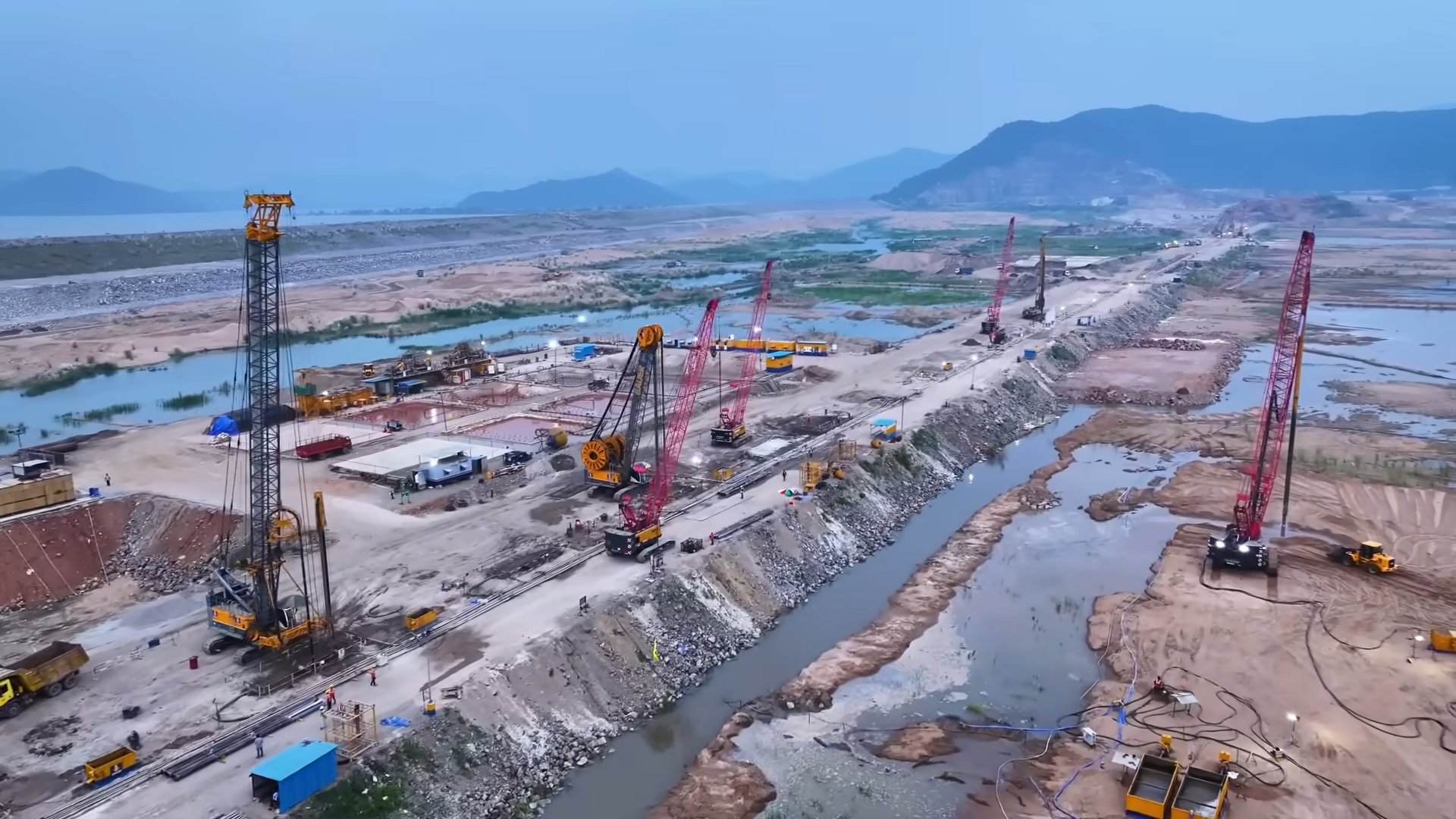Experts warned that altered Polavaram backwater levels could put parts of Khammam and Bhadradri Kothagudem districts at risk.
Published Nov 25, 2025 | 4:34 PM ⚊ Updated Nov 25, 2025 | 5:08 PM

Polavaram Project. Credit: x.com/IndiaInfra02
Synopsis: Telangana is gearing up to fiercely oppose Andhra Pradesh’s rebranded Polavaram–Nallamala Sagar project, calling it the old Polavaram–Banakacherla plan in disguise. Minister Uttam Kumar Reddy warns it threatens Telangana’s 1,119 TMC Godavari share. With AP pushing a new DPR, Telangana vows legal and diplomatic battle at the Centre and Supreme Court to protect its water rights.
Telangana is gearing up for a battle with the Centre over Andhra Pradesh’s revised Polavaram–Nallamala Sagar project.
The state government is getting ready to pitch in an argument that the redesigned project is like the same horse with a different saddle, threatening to steal Telangana’s rightful share in Godavari waters.
Irrigation Minister N Uttam Kumar Reddy has already raised a red flag. During his recent meeting with Union Jal Shakti Minister CR Patil, he voiced his suspicion that Andhra Pradesh is pursuing the controversial project.
With the AP government ordering a detailed project report for the rebranded plan—giving engineers a one-year deadline and allocating Rs 9.1 crore for the task, Telangana is scrambling to build a watertight argument before the Centre against the Trojan horse.
Uttam Kumar Reddy has made it clear that the state will “not back down” when it comes to protecting Telangana’s Godavari allocations. He warned that the project, even in its reworked design, remains “fundamentally flawed.”
In his representaiton to the union minister, he pulled no punches. Telangana, he said, had opposed the original Polavaram–Banakacherla Link Project (PBLP) from day one, and changing the terminal point now does not wash away its irregularities. “Despite AP changing the terminal point, Telangana continues to stand firm in its opposition to the illegally conceived project,” he had said.
The new proposal shifts focus to the Nallamala Sagar reservoir in Prakasam district. But Telangana sees this as a clever sleight of hand. Officials argue that the redesign is meant to divert up to 200 TMC of Godavari “surplus” waters into the Krishna basin, potentially upsetting Telangana’s allocations under the Godavari Water Disputes Tribunal (GWDT) and the Andhra Pradesh Reorganisation Act, 2014. For Telangana, this is a red line.
The roots of the controversy go back to mid-2025. It was then that Andhra Pradesh Chief Minister N. Chandrababu Naidu unveiled the PBLP as an Rs 80,000–90,000 crore game-changer for Rayalaseema. Marketed as a drought-buster, the project promised irrigation for more than 12 lakh acres, drinking water for 80 lakh people, and 20 TMC for industries.
The scheme, billed as visionary, planned to lift and channel Godavari floodwaters through an elaborate system of canals, pumps, pipelines, and a 25.6-km tunnel carved beneath the Nallamala forest. Naidu had said the project simply aimed to make use of “water going waste into the sea,” insisting it would not harm downstream states.
Telangana’s reaction was sharp. Uttam Kumar Reddy declared that “Telangana won’t allow the Polavaram–Banakacherla project at any cost,” accusing Andhra of crossing a line by proceeding without co-basin consultations. The state alleged that the proposal violated GWDT awards, which allocate Telangana 1,119.45 TMC, and breached Section 90 of the Reorganisation Act, meant to safeguard water rights after bifurcation.
Environmentalists too raised alarm bells over potential damage to the Nallamala biosphere reserve, a UNESCO tentative World Heritage site home to leopards, sloth bears and rare plant species. Experts also warned that altered Polavaram backwater levels could put parts of Khammam and Bhadradri Kothagudem districts at risk.
By July, the project had hit another roadblock. The Expert Appraisal Committee (EAC) withheld environmental clearances, citing incomplete hydrological studies. Patil proposed a high-level committee in the same month to mediate between the two states, but the process dragged its feet amid murmurs of bias.
The AP government eventually hit the brakes. On November 7, it cancelled tenders for preparing the original DPR. A new version—the Polavaram–Nallamala Sagar project—was rolled out at an estimated cost of Rs 58,000 crore. The redesign trimmed costs by nearly 35% by dropping the tunnel and replacing it with open canals linked to the existing Veligonda system.
But Telangana remains unconvinced. For Hyderabad, the renaming is merely semantics. Reddy, in his representation to the Centre, urged Patil “not to fall for Andhra Pradesh modifying its PBLP with a new terminal point and a new name.” He slammed Andhra’s assertion that the project would use “flood waters” from the Godavari. “There is no such concept under GWDT or NITI Aayog guidelines,” he argued. Telangana fears that if Maharashtra and Karnataka begin staking claims to so-called flood waters, its own allocations may be thrown into disarray.
According to official sources, Telangana is preparing to send a high-level delegation to Delhi next week. The government is also weighing the option of seeking Supreme Court oversight. Meanwhile, it is pushing ahead with its own Palamuru–Ranga Reddy Lift Irrigation Scheme, for which it is seeking clearance to draw 45 TMC.
Andhra Pradesh, for its part, defends the rework as a pragmatic shift in strategy. Officials describe it as a staged approach designed to avoid cost overruns and lengthy delays.
Under the plan, water will be pumped from Polavaram to Prakasam Barrage, then lifted through the Nagarjuna Sagar Right Canal to the Bollapalli reservoir, before reaching Nallamala Sagar. Surplus water could later be diverted to Somasila, with nearly 400 MW hydropower generated along the way.
As both states dig in their heels in, the stage is set for yet another battle over the region’s most politicised resource—water.
(Edited by Amit Vasudev)
